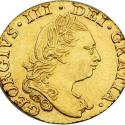A Scion Society of The Baker Street Irregulars

The Curious Incident of the Guinea Coin (2016)
“No coins were to be found”
– The Adventure of the Engineer’s Thumb (ENGR)

I read a pastiche recently in which Sherlock Holmes pays somebody for something with “a guinea coin.” Or perhaps I should say, I read another pastiche recently in which such a thing happens. No doubt the author was trying to establish an atmosphere of Victorian authenticity — but the result was the very opposite, as Holmes would not, could not, have done such a thing. And here is why.
The “guinea” was a gold coin first minted in 1663, and in general use for the rest of the seventeenth and eighteenth centuries, at least in those strata of society where you might expect to find people using gold coins.
With a diameter of an inch, it contained about 8.4 grams of gold, which at today’s gold prices would be worth a bit more than $300. Money for the less affluent consisted of shillings (the shilling coin contained 5.6 grams of silver, today worth around $2.75) and pennies (each one-twelfth of a shilling).
With the economic instability that followed the French revolution and then the Napoleonic wars, the government looked for an alternative, cheaper currency. Paper money (“notes”) became legal tender in 1797, and the last guineas were minted in 1799. (An exception: there was an issue of guineas in 1813 to pay the army that was fighting in the Peninsular War in Spain, when it became clear that the locals would accept no currency except gold.) The “great recoinage” of 1816 defined the pound as the principal unit of money.
A guinea had traditionally been worth 21 shillings, although when the price of gold went up, it could be significantly more. A pound was defined as 20 shillings, and accordingly the new coin was smaller than the old guinea, about seven-eighths of an inch in diameter and containing about 7.3 grams of gold. Its intrinsic value was, as quick mathematics will show, significantly more than that of 20 silver shillings — an example of the “bimetallic question” with which Mycroft Holmes was concerned in “The Bruce-Partington Plans.”
The gold one-pound coin was generally known as a “sovereign,” and figures several times in the Canon; Holmes was given one by Irene Adler as a tip for serving as a witness at her wedding, and said he planned to wear it on his watch-chain. Guinea coins, however, make no appearance, and for good reason: they had been out of general use for some 80 years by the time Holmes’s career was getting under way.
So why are guineas mentioned at all? Because they were still sometimes used in the prices of luxury goods and the fees of professionals. Indeed, they still are, as prices at art galleries and, oddly, livestock auctions may still be quoted in guineas. With the decimalization of British currency, 21 shillings is now expressed as £1.05, and a pretentiously expressed 500-guinea price would be £525 in ordinary money.
An expensive dress in “Silver Blaze” priced at 22 guineas, a pair of horses in “A Scandal in Bohemia” worth 150 guineas apiece, a 13-guinea medical bill in “The Missing Three-Quarter,” Holmes’s violin with its value of 500 guineas — these are typical uses of the old currency in Victorian times. A particularly interesting usage comes in “The Resident Patient,” as Dr. Percy Trevelyan talks about his financial arrangement with Mr. Blessington, who gave him “five [shillings] and three-pence for every guinea that I had earned,” that is, 25 per cent of the gross revenue.
One does wonder why Holmes promised “a guinea to the boy who finds the boat” in The Sign of the Four, and why guineas are mentioned in cab-fares in A Study in Scarlet and “A Scandal in Bohemia.” (The basic cab-fare in central London was sixpence a mile.) Interestingly, these are the first three stories, and it seems not impossible that the young Arthur Conan Doyle, whose total income for his first year in medical practice was £154, was trying to sound impressive without much personal experience of guineas.
If that’s correct, those pastiche authors are in good company in making their guinea mistake.
This post was originally was published on April 6, 2016 at I Hear of Sherlock Everywhere and is reprinted here with the permission of the author and publishers.
 Chris Redmond, BSI (“Billy), M.Bt. is a longtime Sherlockian who is well known to netizens through his work as founder of Sherlockian.Net, one of the central repositories of Sherlock Holmes materials, resources and people on the web today. Chris is the author of a number of groundbreaking an controversial books such as A Sherlock Holmes Handbook and In Bed with Sherlock Holmes and others, as well as numerous Sherlockian articles. He is a member of the Baker Street Irregulars, the Bootmakers of Toronto, the Adventuresses of Sherlock Holmes, and other societies. He lives in Waterloo, Ontario, Canada.
Chris Redmond, BSI (“Billy), M.Bt. is a longtime Sherlockian who is well known to netizens through his work as founder of Sherlockian.Net, one of the central repositories of Sherlock Holmes materials, resources and people on the web today. Chris is the author of a number of groundbreaking an controversial books such as A Sherlock Holmes Handbook and In Bed with Sherlock Holmes and others, as well as numerous Sherlockian articles. He is a member of the Baker Street Irregulars, the Bootmakers of Toronto, the Adventuresses of Sherlock Holmes, and other societies. He lives in Waterloo, Ontario, Canada.

To my way of thinking, it is quite likely that guineas circulated, well into the Victorian era. The British just don’t seem to be coin collectors! On my first trip to England (1958), I collected, from pocket change, farthings from 1910 & 1911 – saved them, as they were the birth years of, respectively, my mother and father.
Perusing the Spink (2015) “Standard Catalog of British Coins”, the values of Guineas, from 1787 thru 1798, in “Fair” condition, are all quoted at £300 (about $395 as of today). Compare this to a U.S. $5 gold coin, which, from 1795 thru 1833, does not show any value for a grade F-12 coin, of less than $3000, in my 2017 “Redbook”. The $5 of 1873 is the first coin in “Redbook” to be valued under $400, for a VF-20 grade, at that. That is why I surmise that the British are not nearly as avid in coin collecting as are we!
William Meskan, member: The 4th Garrideb; Scotland Yarders; Sherlockians by Invitation Only Society; Hugo’s Companions; Col. Sebastian Moran’s Secret Gun Club; Detectives of Chicago Central and other Sherlockian societies.